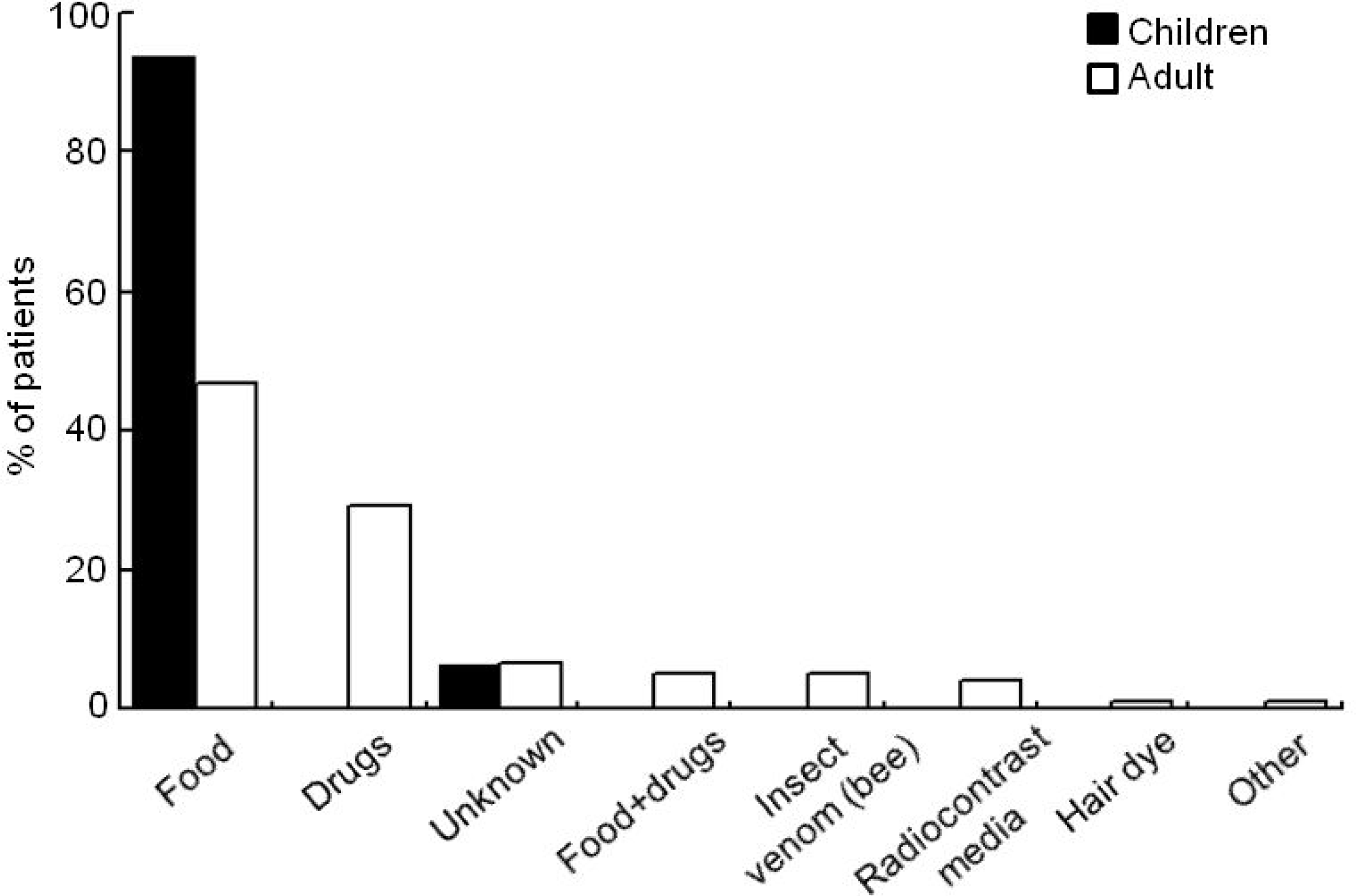Abstract
Purpose
The studies concerning the clinical features of patients with anaphylaxis, who meet the newly established diagnostic criteria, are reported in Korea, but comparative studies regarding the clinical features of children and adult patients with anaphylaxis are lacking. The purpose of this study is to compare the clinical features of the children and adults with anaphylaxis, who meet the new diagnostic criteria at a single hospital.
Methods
We reviewed the medical records of patients who were diagnosed with anaphylaxis, anaphylactic shock, urticaria, and angioedema, including inpatients, outpatients and emergency room visited patients, at the National Medical Center from July, 2005 to August, 2011. The clinical characteristics of children and adults, who met the new diagnostic criteria for anaphylaxis, were analyzed.
Results
We identified 91 patients with anaphylaxis. Sixteen were children and 75 were adults. The sex ratio (male:female) and the mean age were 1:1.7 and 9.6 years among children, respectively, and 1:2.3 and 42.3 years, respectively, among adults. The most common cause of anaphylaxis based on clinical history was foods in 15 children (93.7%) and 35 adults (46.7%). Twelve children (75%) and 36 adults (48%) were rediagnosed with anaphylaxis. Patients with cardiovascular symptoms and severe severity were 1 (6.3%) and 1 (6.3%), respectively, among children, and 28 (37.3 %) and 23 (30.3%), respectively, among adults.
Conclusion
We rediagnosed some cases of anaphylaxis, using the new diagnostic criteria and most of the cases were diagnosed initially as urticaria or angioedema. The adults had more severe and more cardiovascular symptoms than children. In the future, a nationwide, multiinstitutional research will be necessary for the prevalence and the clinical features of anaphylaxis by the new diagnostic criteria in Korea.
References
2. Sampson HA, Munoz-Furlong A, Campbell RL, Adkinson NF Jr, Bock SA, Branum A, et al. Second symposium on the definition and management of anaphylaxis: summary report: Second National Institute of Allergy and Infectious Disease/Food Allergy and Anaphylaxis Network symposium. J Allergy Clin Immunol. 2006; 117:391–7.
3. Kliegman RM, Stanton BF. Nelson textbook of pediatrics. 19th Ed.Saunders: Elsevier;2011. p. 816–9.
4. Yocum MW, Butterfield JH, Klein JS, Volcheck GW, Schroeder DR, Silverstein MD. Epidemiology of anaphylaxis in Olmsted County: A population-based study. J Allergy Clin Immunol. 1999; 104(2 Pt 1):452–6.

6. Simons FE, Ardusso LR, Bilo MB, El-Gamal YM, Ledford DK, Ring J, et al. World Allergy Organization guidelines for the assessment and management of anaphylaxis. J Allergy Clin Immunol. 2011; 127:587–93.e1–22.

7. Yang MS, Lee SH, Kim TW, Kwon JW, Lee SM, Kim SH, et al. Epidemiologic and clinical features of anaphylaxis in Korea. Ann Allergy Asthma Immunol. 2008; 100:31–6.

8. Seo MH, Kim SH, Hong JS, Kim WY, Choe SW. Clinical features of food-induced anaphylaxis in the southeastern coasted area of Korea. Korean J Asthma Allergy Clin Immunol. 2010; 30:110–5.
9. Kim MJ, Choi GS, Um SJ, Sung JM, Shin YS, Park HJ, et al. Anaphylaxis; 10 years' experience at a university hospital in Suwon. Korean J Asthma Allergy Clin Immunol. 2008; 28:298–304.
10. Roh EJ, Chung EH, Lee MH, Lee SJ, Youn YS, Lee JH, et al. Clinical features of anaphylaxis in the middle area of South Korea. Pediatr Allergy Respir Dis(Korea). 2008; 18:61–9.
11. Han SG, Ahn R, Kim SH, Choe SW, Hong ES. Drug-induced anaphylactic shock at the emergency department. J Korean Soc Clin Toxicol. 2009; 7:137–42.
12. Kim HB, Kim DK. Clinical features and treatment patterns of radiocontrast mediainduced anaphylaxis in the emergency department. J Korean Soc Emerg Med. 2009; 20:709–14.
13. Brown SG. Clinical features and severity grading of anaphylaxis. J Allergy Clin Immunol. 2004; 114:371–6.

15. Smit DV, Cameron PA, Rainer TH. Anaphylaxis presentations to an emergency department in Hong Kong: incidence and predictors of biphasic reactions. J Emerg Med. 2005; 28:381–8.

16. Park JS, Park HS, Lee SY, Jung YS, Cho JP. Anaphylactic shock patients admitted in the emergency department of a tertiary hospital. J Korean Soc Emerg Med. 2001; 12:84–90.
17. Mehr S, Liew WK, Tey D, Tang ML. Clinical predictors for biphasic reactions in children presenting with anaphylaxis. Clin Exp Allergy. 2009; 39:1390–6.

18. Greenberger PA, Rotskoff BD, Lifschultz B. Fatal anaphylaxis: postmortem findings and associated comorbid diseases. Ann Allergy Asthma Immunol. 2007; 98:252–7.

19. Mueller UR. Cardiovascular disease and anaphylaxis. Curr Opin Allergy Clin Immunol. 2007; 7:337–41.

20. Novembre E, Cianferoni A, Bernardini R, Mug-naini L, Caffarelli C, Cavagni G, et al. Anaphylaxis in children: clinical and allergologic features. Pediatrics. 1998; 101:E8.

21. Braganza SC, Acworth JP, Mckinnon DR, Peake JE, Brown AF. Paediatric emergency department anaphylaxis: different patterns from adults. Arch Dis Child. 2006; 91:159–63.

22. Brown SG, Blackman KE, Stenlake V, Heddle RJ. Insect sting anaphylaxis; prospective evaluation of treatment with intravenous adrenaline and volume resuscitation. Emerg Med J. 2004; 21:149–54.

23. Clark AT, Ewan PW. The prevention and management of anaphylaxis in children. Curr Paediatr. 2002; 12:370–5.

24. Jirapongsananuruk O, Bunsawansong W, Piya-phanee N, Visitsunthorn N, Thongngarm T, Vichyanond P. Features of patients with anaphylaxis admitted to a university hospital. Ann Allergy Asthma Immunol. 2007; 98:157–62.

25. Scranton SE, Gonzalez EG, Waibel KH. Incidence and characteristics of biphasic reactions after allergen immunotherapy. J Allergy Clin Immunol. 2009; 123:493–8.

26. Simons FE. Anaphylaxis: recent advances in assessment and treatment. J Allergy Clin Immunol. 2009; 124:625–36.

27. Sicherer SH, Simons FE. Section on Allergy and Immunology, American Academy of Pediatrics. Self-injectable epinephrine for first-aid management of anaphylaxis. Pediatrics. 2007; 119:638–46.

28. Gold MS, Sainsbury R. First aid anaphylaxis management in children who were prescribed an epinephrine autoinjector device (EpiPen). J Allergy Clin Immunol. 2000; 106(1 Pt 1):171–6.

Table 1.
Demographic Characteristics of Patients with Anaphylaxis
Table 2.
The Initial Diagnosis before Using the New Diagnostic Criteria for Anaphylaxis
Table 3.
Clinical Manifestations, Symptom Severity and Clinical Progression of Patients with Anaphylaxis
Table 4.
Observation Time and Hospital Utilization Pattern of Anaphylactic Patients
Table 5.
Treatment of Anaphylactic Patients




 PDF
PDF ePub
ePub Citation
Citation Print
Print



 XML Download
XML Download